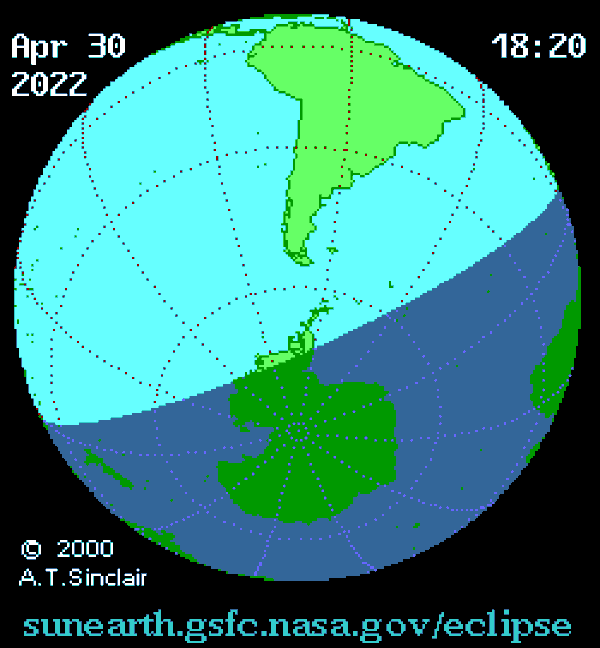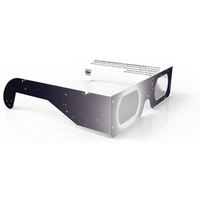Update for 6:14 pm ET: TimeandDate.com's webcast for the partial solar eclipse of April 30, 2022 from Chile and Argentina has ended as the sun has set during mid-eclipse. Check out the amazing views from the video above. Read our full wrap story on the solar eclipse.
This year, humans on Earth will experience four eclipses: two of the sun and two of the moon. The first of these is a solar eclipse set to take place on Saturday.
Interestingly, this partial solar eclipse of April 30 will involve the second of two new moons in the month of April, what colloquially is known as a "Black Moon."
During this upcoming solar eclipse, the dark shadow cone of the moon, from where a total eclipse can be seen, will completely miss the Earth, passing approximately 750 miles (1,200 kilometers) below the South Pole.
But the moon's outer shadow, or penumbra, will scrape a part of the Southern Hemisphere, resulting in a partial eclipse that will be visible near sunset across a swath of the South Pacific and Southern Oceans, as well as in southern and western portions of South America, including Chile, Argentina, Uruguay, southern Peru southern Bolivia, western Paraguay and a tiny slice of Brazil.
Related: How to watch the April 2022 solar eclipse online
The greatest eclipse, or the moment when the axis of the moon's shadow cone will be closest to Earth's center, will take place over the Southern Ocean (see green star), 300 miles (480 km) to the northwest of Yelcho Base, a Chilean Antarctic Research Base at South Bay, Doumer Island.
Get the Space.com Newsletter
Breaking space news, the latest updates on rocket launches, skywatching events and more!
A ship or trawler near this spot will see the sun will barely clear the west-northwest horizon, with nearly two-thirds of its diameter (63.96%) hidden behind the moon. The normally thick haze on the horizon could attenuate and redden with the sun's light, giving it the appearance of a slice of cantaloupe melon. Unfortunately, no part of this eclipse will be visible from the Northern Hemisphere.
That said, you can prepare for the next solar eclipses with our guide on how to photograph a solar eclipse safely. Our guides on the best cameras for astrophotography and the best lenses for astrophotography can help you pick the best gear is right for you to catch them on camera.
Below are viewing circumstances that I calculated, courtesy of Fred Espenak's Eclipsewise.com website — for some selected cities in South America within the viewing zone of the eclipse. Local times apply.
(Dashes indicate that the sun sets and is not visible. Magnitude is the fraction of the solar diameter covered at maximum. Obscuration is the amount of coverage of the total disk area of the sun.)
| City | Eclipse Starts | Maximum | Magnitude | Obscuration | Sunset |
| Santiago | 4:32 p.m. | 5:36 p.m. | 0.41 | 29% | 6:03 p.m. |
| Ushuala | 4:46 p.m. | 5:57 p.m. | 0.62 | 52% | 6:08 p.m. |
| Asunción | 5:12 p.m. | --- | --- | --- | 5:22 p.m. |
| La Paz | 5:38 p.m. | 6:01 p.m. | 0.05 | .01% | 6:15 p.m. |
| Buenos Aires | 5:42 p.m. | --- | --- | --- | 6:12 p.m. |
| Montevideo | 5:43 p.m. | --- | --- | --- | 6:03 p.m. |
The mechanics of a solar eclipse

A solar eclipse can only happen at a new moon phase, when the sun, moon and Earth are positioned in a straight line. However, the moon's orbit is slightly off-kilter relative to the Earth's orbital plane (called the ecliptic) by an amount of just over 5 degrees. This means that, more often than not, when the moon arrives at a new moon phase, it passes either just above or just below the sun; thus, no eclipse can occur.
The point where the orbital planes of the Earth and moon cross is called a node. If the moon is new when it reaches the nodal crossing point, a solar eclipse will result. If the moon arrives at the node within several hours of a new phase, the sun-moon-Earth alignment will be such that the moon will appear to pass directly in front of the sun, resulting in a "central" solar eclipse. Depending on the distances of the moon to the Earth and the Earth to the sun, the resulting eclipse will either be total or annular (ring-shaped).
However, in the case of the upcoming April 30 solar eclipse, the moon will reach a new phase 23 hours and 26 minutes before it reaches the node. That's too far away to allow the moon to pass directly in front of the sun, but still just near enough to allow the moon to, at the very least, cover a part of the sun.
Be careful...
If you find yourself within a viewing zone of this or any other solar eclipse: DO NOT LOOK DIRECTLY TOWARD THE SUN!
Some safety tips for viewing a solar eclipse:
- Project the sun's image through a pinhole camera, or through binoculars or a telescope, onto a piece of white cardboard or a similarly colored sheet of paper and view the sun's "shadow" on the paper.
- View the sun for short intervals through specially-made "eclipse glasses," but still take caution when doing so.
- Look at the sun for short intervals through a No. 13 or No. 14 welder’s glass; this will also appear to turn the sun a shade of green.
- Do NOT view the sun through smoked glass, crossed polarizing filters or colored water. They may seem to dim the sun, but the sun’s invisible infrared rays will still get through.
- Do NOT look through a telescope, even with a specialized filter, unless you really know what you are doing. Any filter that you may use should be placed over the front, NOT behind the eyepiece.
Soluna Solar Eclipse Glasses (10 pack) $99.99 now $11.99 on Amazon.
Save 88% on these solar eclipse glasses that are made by a NASA-approved manufacturer and be ready for the next sun event. They've been independently tested for direct sunlight viewing and score highly with thousands of reviews. Perfect if you're viewing the solar eclipse as a group.
Note: the original price is very high so there's a chance this is so to make it look like a bigger deal, the price you pay is still good though.
More safety tips can be found here.
Coming attractions
On Oct. 25, the second solar eclipse of 2022 will occur. Like in April, this eclipse will be a partial eclipse, but this time the moon's penumbral shadow will fall on the Northern Hemisphere.
The event will be visible from northern and eastern portions of Africa, most of Europe (save for southern Spain and Portugal), the Middle East, the Indian Subcontinent and a part of northern and western Russia. The greatest eclipse will take place over Russia, with 86% of the sun's diameter covered by the moon.
2023 will see two solar eclipses, but they will be central. On April 20, 2023, a "hybrid" eclipse, that is, an eclipse that starts as an annular, then transitions to total, then back to an annular before ending, will be visible from the Indian Ocean, extreme western Australia, New Guinea and the Pacific Ocean.
And, on Oct.14, 2023, an annular solar eclipse will sweep from the Pacific coast of Oregon to the Texas Gulf Coast. The track of annularity will also pass across Mexico’s Yucatan Peninsula down through Central America and across northern portions of South America. Most of the rest of the Western Hemisphere will see a partial eclipse.
Getting back to the upcoming solar eclipse, if you are among the nearly 100 million people within the South American eclipse viewing zone, we wish you clear skies and safe viewing!
Joe Rao serves as an instructor and guest lecturer at New York's Hayden Planetarium. He writes about astronomy for Natural History magazine, the Farmers' Almanac and other publications. Follow us on Twitter @Spacedotcom and on Facebook.
Join our Space Forums to keep talking space on the latest missions, night sky and more! And if you have a news tip, correction or comment, let us know at: community@space.com.

Joe Rao is Space.com's skywatching columnist, as well as a veteran meteorologist and eclipse chaser who also serves as an instructor and guest lecturer at New York's Hayden Planetarium. He writes about astronomy for Natural History magazine, Sky & Telescope and other publications. Joe is an 8-time Emmy-nominated meteorologist who served the Putnam Valley region of New York for over 21 years. You can find him on Twitter and YouTube tracking lunar and solar eclipses, meteor showers and more. To find out Joe's latest project, visit him on Twitter.










